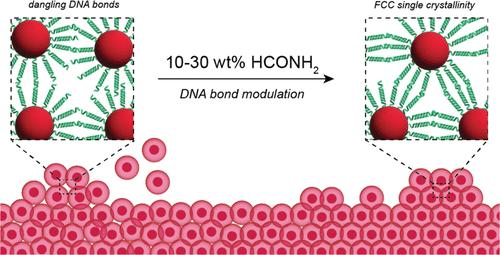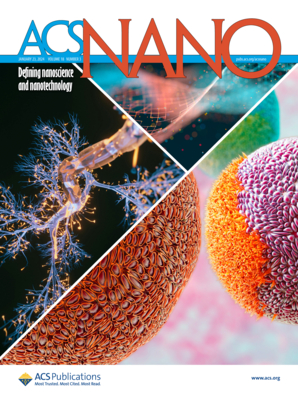Organic Modulators Enable Morphological Diversity in Colloidal Crystals Engineered with DNA
IF 15.8
1区 材料科学
Q1 CHEMISTRY, MULTIDISCIPLINARY
引用次数: 0
Abstract
Colloidal crystal engineering with DNA is a powerful way of generating a wide variety of crystals spanning over 90 different symmetries. However, in many cases, crystals with well-defined habits are difficult, if not impossible, to make, in part due to rapid crystal defect formation and propagation. This is especially true in the case of face-centered cubic (FCC) structures. Herein, we report a strategy that uses formamide as a chemical modulator to slow down colloidal crystal growth, which decreases defect formation and yields higher-quality crystals. Formamide forms hydrogen bonds with DNA bases and destabilizes the DNA duplex; in the context of colloidal crystallization, formamide leads to the disassembly of undercoordinated particles (defect architectures) and facilitates their reassembly into structures with the maximum number of nearest-neighbor contacts and DNA bonds. When targeting an FCC lattice comprised of DNA-modified spherical 20 nm particles, formamide promotes the formation of its Wulff polyhedron (a truncated octahedron), never observed before in colloidal crystal engineering with DNA. Importantly, kinetic habits, including tetrahedra, octahedra, icosahedra, and decahedra, are also observed depending on formamide concentration.

求助全文
约1分钟内获得全文
求助全文
来源期刊

ACS Nano
工程技术-材料科学:综合
CiteScore
26.00
自引率
4.10%
发文量
1627
审稿时长
1.7 months
期刊介绍:
ACS Nano, published monthly, serves as an international forum for comprehensive articles on nanoscience and nanotechnology research at the intersections of chemistry, biology, materials science, physics, and engineering. The journal fosters communication among scientists in these communities, facilitating collaboration, new research opportunities, and advancements through discoveries. ACS Nano covers synthesis, assembly, characterization, theory, and simulation of nanostructures, nanobiotechnology, nanofabrication, methods and tools for nanoscience and nanotechnology, and self- and directed-assembly. Alongside original research articles, it offers thorough reviews, perspectives on cutting-edge research, and discussions envisioning the future of nanoscience and nanotechnology.
 求助内容:
求助内容: 应助结果提醒方式:
应助结果提醒方式:


